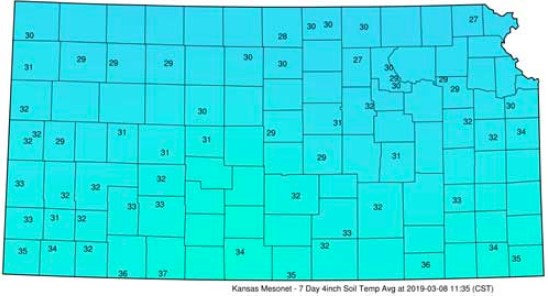With the long, wet fall and winter across most of Kansas, many producers could not apply N fertilizer due to the persistent saturated soil conditions (Figure 1). For those that applied N in the fall or had a failed crop do to last summer’s drought and are anticipating residual profile N the question is concerning possible loss of nitrogen (N), while others are considering alternative sources besides anhydrous ammonia this spring.
Figure 1. Fall soil moisture vs current (Kansas Mesonet)
Potential for N loss from fall-applied N
Nitrogen loss processes are associated with the nitrate-N (NO3) form of nitrogen. The process of nitrification is a biological process and is driven by soil oxygen content, soil temperature, pH, how the N is applied, and some characteristics of the fertilizer. Nitrification is an aerobic process, thus requiring high levels of soil oxygen. Conditions that reduce oxygen supplies, such as wet soils, will inhibit nitrification and keep N in the ammonium form. In addition, the cold soils in recent months minimize any microbial activity and the conversion to the nitrate-N form (Figure 2). Thus, up to this point, the fall-applied N fertilizer will not be subject to loss given the recent conditions of frozen soils across the state. Fertilizer applied as ammonia or urea, and the 75% of UAN that is in ammonium/ammonium-producing forms, will remain in the soil in the ammonium form until soils warm up and dry out later in the spring.

Figure 2. Average 4-inch soil temperatures for week ending 3/8/2019 (Kansas Mesonet)
Residual profile N
The amount of nitrogen in the profile can be hard to predict. The good news is that it is not too late to collect 24-inch profile soil samples to determine how much N is available for the upcoming crop. Due to the wet fall (Figure 3), it is possible that some of last year’s N was lost due to leaching and denitrification. However, the potential exists for a significant amount to still be retained in the soil profile. Taking profile N samples this spring will allow producers to account for and take advantage of unutilized N and could represent a savings on N inputs this year. For more information on collecting and submitting profile N soil samples, please see KSRE publication
MF734, “Soil Testing Laboratory”.
Figure 3. Total fall and winter precipitation (October 1, 2018 to March 7, 2019). (Weather Data Library)
Alternative N sources and timing
With wet soil conditions, some producers are considering switching to urea or UAN instead of anhydrous ammonia. These nitrogen sources are agronomically equivalent when applied correctly, and therefore are good alternatives. Dry and liquid fertilizer might provide more flexibility for application timing including pre-plant and side-dress N applications. With current corn hybrids, N uptake can generally extend to later in the growing season, providing a bigger window for side-dress N applications. However, some N at planting will be required depending on the intended timing for side-dress N application. For those using starter fertilizers, N can be applied at this time. With a 2x2 or dribble on the surface (2x0), higher rates of N are safe, and applications of at least 20-30 lbs can provide N during early growth, with the rest of the N applied as early side-dress (V6-V8 growth stage). Split-applied N can provide additional benefits including higher nitrogen use efficiency and reduced N loss potential for some soils.
With surface applied side-dress urea or UAN, the applications should be ideally planned before a forecasted rain that can help to move the N in the soil, or consider the use of a urease inhibitor to reduce the risk of N volatilization. Injecting the N fertilizer is another alternative to manage the risk of N volatilization or tie-up.